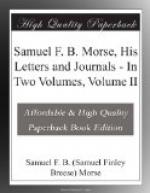This remains true to the present day, and is one of the remarkable features of this great invention. The germ of the “Morse system,” as jotted down in the 1832 sketch-book, is the basic principle of the universal telegraph of to-day.
In another letter to Mr. Wood, of September 11, 1864, referring to the sad death of the son of a mutual friend, he touches on two of the great enigmas of life which have puzzled many other minds:—
“It is one of those mysteries of Providence, one of those deep things of God to be unfolded in eternity, with the perfect vindication of God’s wisdom and justice, that children of pious parents, children of daily anxiety and prayer, dedicated to God from their birth and trained to all human appearance ‘in the way they should go,’ should yet seem to falsify the promise that ‘they should not depart from it.’ It is a subject too deep to fathom.
“... It is my daily, I may say hourly, thought, certainly my constant wakeful thought at night, how to resolve the question: ’Why has God seen fit so abundantly to shower his earthly blessings upon me in my latter days, to bless me with every desirable comfort, while so many so much more deserving (in human eyes at least) are deprived of all comfort and have heaped upon them sufferings and troubles in every shape?’”
The memory of his student days in London was always dear to him, and on January 4, 1865, he writes to William Cullen Bryant:—
“I have this moment received a printed circular respecting the proposed purchase of the portrait of Allston by Leslie to be presented to the National Academy of Design.
“There are associations in my mind with those two eminent and beloved names which appeal too strongly to me to be resisted. Now I have a favor to ask which I hope will not be denied. It is that I may be allowed to present to the Academy that portrait in my own name. You can appreciate the arguments which have influenced my wishes in this respect. Allston was more than any other person my master in art. Leslie was my life-long cherished friend and fellow pupil, whom I loved as a brother. We all lived together for years in the closest intimacy and in the same house. Is there not then a fitness that the portrait of the master by one distinguished pupil should be presented by the surviving pupil to the Academy over which he presided in its infancy, as well as assisted in its birth, and, although divorced from Art, cannot so easily be divorced from the memories of an intercourse with these distinguished friends, an intercourse which never for one moment suffered interruption, even from a shadow of estrangement?”
It is needless to say that this generous offer was accepted, and Morse at the same time presented to the Academy the brush which Allston was using when stricken with his fatal illness.
As his means permitted he made generous donations to charities and to educational institutions, and on May 20, 1865, he endowed by the gift of $10,000 a lectureship in the Union Theological Seminary, making the following request in the letter which accompanied it:—




